Blue-emitting heteroleptic Ir(iii) phosphors with functional 2,3′-bipyridine or 2-(pyrimidin-5-yl)pyridine cyclometalates†
Abstract
We have synthesized four Ir(III) metal complexes (1–4) bearing dual fluorine-free cyclometalates that are derived from 2′,6′-dimethoxy-4-t-butyl-2,3′-bipyridine (pypy)H or 2-(2,4-dimethoxypyrimidin-5-yl)-4-t-butylpyridine (pmpy)H and a third ancillary, e.g. 5-pyridin-2-yl-pyrazolate (Pz) or 5-pyridin-2-yl-pyrrolide (Pr), respectively. The Ir(III) complexes 3 and 4 were examined by X-ray diffraction studies for providing the structural proofs. Photophysical properties were next measured in CH2Cl2 at RT, among which the pypy complexes 1 and 2 showed an identical structured emission with an E0-0 peak located at 458 nm, while the corresponding pmpy derivative 3 displayed the most blue-shifted E0-0 peak at 444 nm. Organic light-emitting diodes (OLEDs) were fabricated using multiple layered architecture and the aforementioned phosphor at 8 wt% doping level. The associated OLED performances, cf. max. E.Q.E. = 9.0%, 14.3%, 5.8% and 9.4% and CIEx,y coordinates at (0.16, 0.22), (0.16, 0.24), (0.16, 0.17) and (0.16, 0.20) at 100 cd m−2 for phosphors 1–4 in sequence, confirmed their potential to act as blue dopants for phosphorescent OLEDs.


 Please wait while we load your content...
Please wait while we load your content...